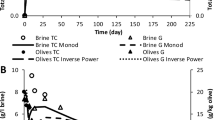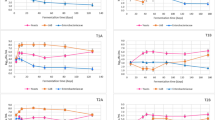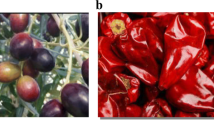Abstract
Six naturally fermented (Greek-style) table olives of cultivars Itrana, Peranzana, Cellina di Nardò, Nocellara del Belice and Bella di Cerignola, as well as their corresponding brines, were studied by a combined strategy consisting of chemical, microbiological and molecular analyses. In particular, organic acids, sugars, polyphenols, fatty acids, biogenic amines and cultivable microbiota were detected by standard methods. Moreover, tyramine and histamine producing bacteria were evaluated by an original approach consisting of Reverse-Transcription (RT)-qPCR. At the end of the fermentation process, mesophilic lactobacilli and yeasts in brine represented the dominating biota, ranging from 6.25 to 7.84 log CFU/ml and from 6.5 to 7.56 log CFU/ml, respectively. Enterobacteriaceae and pathogens were undetectable in all the samples. In general, table olive preparations differed in chemical composition. In particular, C16:0 and C18:2c9,12 concentrations ranged from 9.9 to 18.8 % and from 5.4 to 15.4 % of total fatty acids, respectively. The main fatty acid detected was C18:1c9 while CLAc9, t11 was present only in traces. Polyphenol concentrations greatly differentiated the final product, depending on the cultivar. A low quantity of biogenic amines was found in some samples and biogenic amines producing bacteria were rapidly detectable by RT-qPCR.
Similar content being viewed by others
References
Ancín-Azpilicueta C, González-Marco A, Jiménez-Moreno N (2008) Current knowledge about the presence of amines in wine. Crit Rev Food Sci Nutr 48:257–275
Anderson RE (1988) Biogenic amines in lactic acid fermented vegetables. Lebensm-Wiss Technol 21:68–69
Anonymous (1987) Codex standard for table olives (Codex Stan 66–1981 (Rev. 1–1987). Codex Alimentarius
Arroyo-López FN, Durán-Quintana MC, Ruiz-Barba JL, Querol A, Garrido-Fernández A (2006) Use of molecular methods for the identification of yeast associated with table olives. Food Microbiol 23:791–796
Arroyo-López FN, Querol A, Bautista-Gallego J, Garrido-Fernández A (2008) Role of yeasts in table olive production. Int J Food Microbiol 128:189–196
Asehraou A, Peres C, Brito D, Faid M, Serhrouchni M (2000) Characterization of yeasts strains isolated from bloaters of fermented green table olives during storage. Grasas Aceites 51:225–229
Association Française de Normalisation (1997) Microbiologie des aliments e Recherche des Salmonella e Méthode de routine NF V 08–052
Barnett JA, Payne RW, Yarrow D (2000) Yeast: characteristics and identification, 3rd edn. Cambridge University Press, Cambridge
Blekas G, Vassilakis C, Harizanis C, Tsimidou M, Boskou DG (2002) Biophenols in table olives. J Agric Food Chem 50:3688–3692
Caggia C, Randazzo CL, Di Salvo M, Romeo F, Giudici P (2004) Occurrence of Listeria monocytogenes in green table olives. J Food Protect 67:2189–2194
Cawthorne A, Pastore L, Celentano T, D’Ancona F, Bella A, Massari M, Anniballi F, Fenicia L, Aureli P, Salmaso S (2005) Botulism and preserved green olives. Emerg Infect Dis 11(5):781–782
Ciafardini G, Marsilio V, Lanza B, Pozzi N (1994) Hydrolysis of oleuropein by Lactobacillus plantarum strains associated with olive fermentation. Appl Environ Microbiol 60:4142–4147
COI (2004) Trade standard applying to table olives. International olive oil council COI/OT/NC no. 1, Dezembro de 2004
De Bellis P, Valerio F, Sisto A, Lonigro SL, Lavermicocca P (2010) Probiotic table olives: microbial populations adhering on olive surface in fermentation sets inoculated with the probiotic strains Lactobacillus paracasei IMPC2.1 in an industrial plant. Int J Food Microbiol 140:6–13
Fernández M, del Río B, Linares DM, Martin MC, Alvarez MA (2006) Real-time polymerase chain reaction for quantitative detection of histamine-producing bacteria: use in cheese production. J Dairy Sci 89:3763–3769
Fernández M, Linares D, del Río B, Ladero V, Alvarez MA (2007) HPLC quantification of biogenic amines in cheeses: correlation with PCR-detection of tyramine-producing microorganisms. J Dairy Res 74:276–282
Galgano F, Suzzi G, Favati F, Caruso MC, Martuscelli M, Gardini F, Salzano G (2001) Biogenic amines during ripening in “Semicotto Caprino” cheese: role of enterococci. Int J Food Sci Tech 36:153–160
García-García P, Brenes Balbuena M, Romero Barranco C, Garrido-Fernández A (2001) Biogenic amines in packed table olives and pickles. J Food Protect 64:374–378
Garrido-Fernández A, Fernandez Diez M, Adams N (1997) Table olives: production and processing. Chapman and Hall, London, p 15
Hernández A, Martín A, Aranda E, Pérez-Nevado F, Córdoba MG (2007) Identification and characterization of yeast isolated from the elaboration of seasoned green table olives. Food Microbiol 24:346–351
Hierro N, Esteve-Zarzoso B, Gonzalez A, Mas A, Guillamon JM (2006) Real-time quantitative PCR (QPCR) and reverse transcription-QPCR for detection and enumeration of total yeasts in wine. Appl Environ Microbiol 72:7148–7155
Hornero-Mendez D, Garrido-Fernandez A (1994) Biogenic-amines in table olives analysis by high-performance liquid-chromatography. Analyst 119:2037–2041
Hurtado A, Reguant C, Esteve-Zarzoso B, Bordons A, Rozès N (2008) Microbial population dynamics during the processing of Aberquina table olives. Food Res Int 41:738–744
IOOC (2004) Norma comercial aplicable a la aceituna demesa. Document COI/OT/NC N 1 Dec, Madrid
ISO (1998) International Organization for Standardization 11290–2. Microbiology of food and animal feeding stuffs e horizontal method for the detection and enumeration of Listeria monocytogenes e Part 2: enumeration method
ISO (2002) International Organization for Standardization 16654. Microbiology of food and animal feeding stuffs e horizontal method for the detection and enumeration of Escherichia coli O157:H7
Issaoui M, Dabbou S, Mechri B, Nakbi A, Chehab H, Hammami M (2011) Fatty acid profile, sugar composition, and antioxidant compounds of table olives as affected by different treatments. Eur Food Res Technol 232:867–876
Kuensch U, Sraerer H, Temperli T (1990) Study on the formation of biogenic amines during sauerkraut fermentation. In: Zeuten P, Cheftel JC, Eriksson C, Gormley TR, Linko P, Paulus K (eds) Processing and quality of foods, vol 2. Food biotechnology: avenues to healthy and nutritious products. Elsevier Applied Science, London, pp 2240–2243
Ladero V, Coton M, Fernández M, Buron N, Cruz Martín M, Guichard H, Coton E, Alvarez MA (2011) Biogenic amines content in Spanish and French natural ciders: application of qPCR for quantitative detection of biogenic amine-producers. Food Microbiol 28:554–561
Lanza B, Di Serio MG, Iannucci E, Russi F, Marfisi P (2010) Nutritional, textural and sensorial characterization of Italian table olives (Olea europaea L. cv. ‘Intosso d’Abruzzo’). Int J Food Sci Tech 45:67–74
López A, Montano A, García P, Garrido A (2006) Fatty acid profile of table olives and its multivariate characterization using unsupervised (PCA) and supervised (DA) chemometrics. J Agric Food Chem 54:6747–6753
Marcobal A, Olo MC, Martin-Alvarez PJ, Moreno-Arribas MV (2005) Biogenic amines content of red Spanish wines: comparison of a direct ELISA and a HPLC method for the determination of histamine in wines. Food Res Int 38:387–394
Martorell P, Querol A, Fernández-Espinar MT (2005) Rapid identification and enumeration of Saccharomyces cerevisiae cells in wine by real-time PCR. Appl Environ Microbiol 11:6823–6830
Morello JR, Romero MP, Motilva MJ (2004) Effect of the maturation process of the olive fruit on the phenolic fraction of drupes and oils from Arbequina, Farga, and Morrut cultivars. J Agric Food Chem 52:6002–6009
Nychas GJE, Panagou EZ, Parker ML, Waldron KW, Tassou CC (2002) Microbial colonization of naturally black olives during fermentation and associated biochemical activities in the cover brine. Lett Appl Microbiol 34:173–177
Ozdestan O, Uren A (2010) A method for benzoyl chloride derivatization of biogenic amines for high performance liquid chromatography. Talanta 78:1321–1326
Panagou EZ, Schillinger U, Franz CMAP, Nychas GJE (2008) Microbiological and biochemical profile of cv conservolea naturally black olives during controlled fermentation with selected strains of lactic acid bacteria. Food Microbiol 25:348–358
Pereira JA, Pereira AP, Ferreira ICFR, Valentão P, Andrade P, Seabra R, Estevinho L, Bento A (2006) Phenolics compounds, antioxidant potential and antimicrobial activity of table olives from Portugal. J Agric Food Chem 54:8425–8431
Pereira AP, Pereira JA, Bento A, Estevinho ML (2008) Microbiological characterization of table olives commercialized in Portugal in respect to safety aspects. Food Chem Toxicol 46:2895–2902
Perricone M, Bevilacqua A, Corbo MR, Sinigaglia M (2010) Use of Lactobacillus plantarum and glucose to control the fermentation of “Bella di Cerignola” table olives, a traditional variety of Apulian region (Southern Italy). J Food Sci 75:M430–M436
Randazzo C, Restuccia C, Romano AD, Caggia C (2002) Lactobacillus casei, dominant species in naturally fermented Sicilian green olives. Int J Food Microbiol 90:9–14
Rejano Navarro L, Gonzáles Cancho F, de la Rodríguez JM (1978) Formation of propionic acid during the storage of green table olives. Grasas Aceites 29:203–210
Rejano L, Montaño A, Casado FJ, Sánchez AH, de Castro A (2010) Olives: varieties and variations. In: Preedy VR, Watson RR (eds) Olives and olive oil in health and disease prevention. Elsevier, London, pp 3–16
Sanchez I, Palop L, Ballesteros C (2000) Biochemical characterization of lactic acid bacteria isolated from spontaneous fermentation of ‘Alamgro’ Eggplants. Int J Food Microbiol 59:9–17
Sánchez AH, de Castro A, Rejano L, Montaño A (2000) Comparative study on chemical changes in olive juice and brine during green olive fermentation. J Agric Food Chem 48:5975–5980
Sousa A, Ferreira ICFR, Barros L, Bento A, Pereira JA (2008) Antioxidant potential of traditional stoned table olives ‘‘Alcaparras”: influence of the solvent and temperature extraction conditions. LWT-Food Sci Technol 41:739–745
Spyropoulou KE, Chorianopoulos NG, Skandamis PN, Nychas GJE (2001) Control of Escherichia coli O157:H7 during the fermentation of Spanish-style green table olives (Conservolea variety) supplemented with different carbon sources. Int J Food Microbiol 66:3–11
Tassou CC, Panagou EZ, Katsaboxakis KZ (2002) Microbiological and physicochemical changes of naturally black olives fermented at different temperatures and NaCl levels in the brines. Food Microbiol 19:605–615
Tofalo R, Torriani S, Chaves-López C, Martuscelli M, Paparella A, Suzzi G (2007) A survey of Saccharomyces populations associated with wine fermentations from the Apulia region (South Italy). Ann Microbiol 57:545–552
Tofalo R, Schirone M, Perpetuini G, Suzzi G, Corsetti A (2012) Development and application of a real-time PCR-based assay to enumerate total yeasts and Pichia anomala, Pichia guillermondii and Pichia kluyveri in fermented table olives. Food Control 23:356–362
Torriani S, Gatto V, Sembeni S, Tofalo R, Suzzi G, Belletti N, Gardini F, Bover-Cid S (2008) Rapid detection and quantification of tyrosine decarboxylase gene (tdc) and its expression in gram-positive bacteria associated with fermented foods using PCR-based methods. J Food Protect 71:93–101
Acknowledgments
This work is part of the project “Tracciabilità, certificazione e tutela della qualità dell’olio di oliva e delle olive da tavola—Azione 4d” supported by grant from UNAPROL (Reg. CE n. 867/2008 Misura 4). The authors thank Dr. Anna Chiara Manetta and Mrs Lorella Di Giuseppe for their precious help with the HPLC analysis. Giorgia Perpetuini is beneficiary of grant financed by the European Social Fund (FSE).
Author information
Authors and Affiliations
Corresponding author
Rights and permissions
About this article
Cite this article
Tofalo, R., Schirone, M., Perpetuini, G. et al. Microbiological and chemical profiles of naturally fermented table olives and brines from different Italian cultivars. Antonie van Leeuwenhoek 102, 121–131 (2012). https://doi.org/10.1007/s10482-012-9719-x
Received:
Accepted:
Published:
Issue Date:
DOI: https://doi.org/10.1007/s10482-012-9719-x




